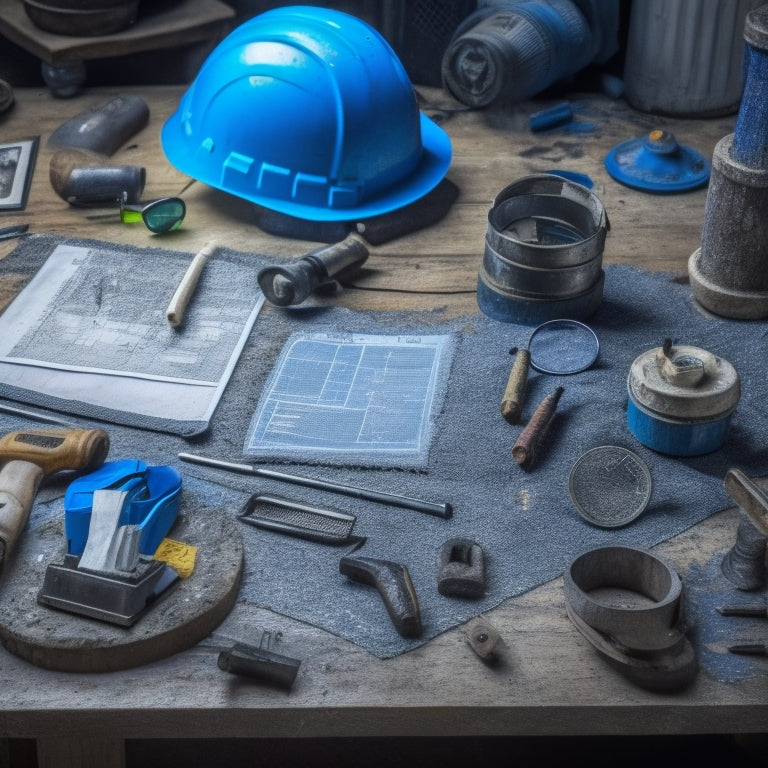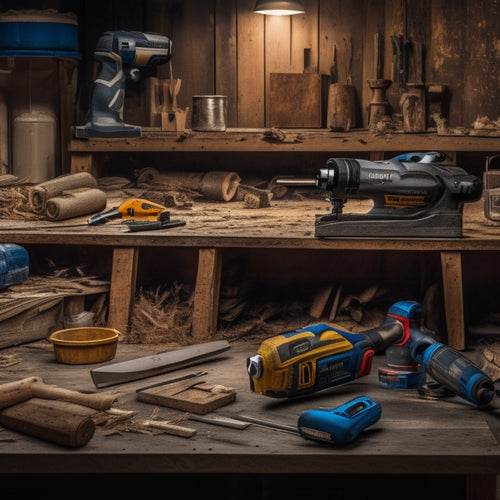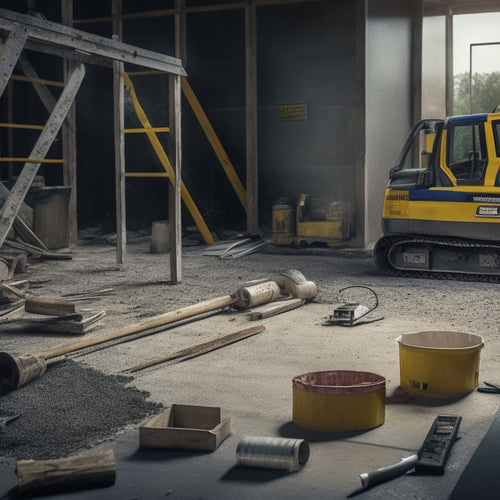
5 Best Troubleshooting Tools for Renovation Success
Share
To guarantee renovation success, you'll want to invest in the right troubleshooting tools to identify and address potential issues early on. Start by scrutinizing substrates for adhesion problems and utilize moisture meters to detect hidden water damage. Regularly inspect and maintain surface preparation tools, such as scrapers and grinders, to prevent damage. Bond strength testing equipment, like tensile and shear testers, will help you evaluate material properties. Finally, employ debonding detection tools, including acoustic emission testing and infrared thermography, to catch signs of debonding and address them promptly. By mastering these tools, you'll be well-equipped to tackle even the most complex renovation projects with confidence.
Key Takeaways
• Utilize a moisture meter to detect hidden water damage and moisture sources, ensuring accurate readings through regular calibration.
• Perform adhesion testing, such as pull-off or tape testing, to assess bond strength between substrate and coating/adhesive.
• Inspect surface preparation tools regularly, checking for dull blades, clogged air vents, and worn-out handles to ensure optimal performance.
• Employ bond strength testing equipment, such as tensile, shear, or peel strength tests, to measure the reliability of material bonds.
• Leverage specialized tools like acoustic emission testing and infrared thermography to detect debonding issues, addressing underlying causes before repairs.
Identifying Adhesion Issues Early
During the surface preparation stage of your renovation project, you should scrutinize the substrate for signs of adhesion issues, as undetected problems can lead to costly rework and compromised structural integrity. Adhesion testing is a vital step in substrate evaluation, helping you identify potential issues before they escalate into major problems.
You'll want to look for signs of delamination, cracking, or peeling, which can indicate inadequate surface preparation or incompatible materials. Performing adhesion testing using techniques such as pull-off testing or tape testing can provide valuable insights into the substrate's condition.
These tests can help you determine the bond strength between the substrate and the coating or adhesive, giving you a clear understanding of the substrate's suitability for the intended application. A thorough substrate evaluation will also involve visual inspections, reviewing the substrate's history, and evaluating environmental factors that may impact adhesion.
Moisture Meter Troubleshooting Essentials
When measuring moisture levels in building materials, you'll often rely on a moisture meter, an essential tool for detecting hidden water damage, pinpointing sources of moisture intrusion, and guaranteeing a successful renovation project.
To get accurate readings, it's vital to understand the principles of moisture measurement and the limitations of your meter. You should calibrate your device regularly to confirm precise results.
In moisture management, humidity control is critical. When using a moisture meter, consider the relative humidity (RH) of the environment, as high RH levels can affect readings.
Take multiple readings in different areas to identify patterns and anomalies. Don't forget to check for surface moisture, as it can skew results.
Use the correct type of meter for the material you're testing, such as a pin-type meter for wood or a non-invasive meter for drywall.
Surface Preparation Tool Checks
You'll need to inspect your surface preparation tools regularly to ascertain they're functioning correctly and not compromising your renovation project's outcome. A malfunctioning tool can lead to inadequate surface preparation, which can result in a weak bond between the substrate and the new material. This can lead to costly repairs and even project failure.
To ascertain your tools are in top condition, perform regular checks on the following:
| Tool | Check for |
|---|---|
| Scraper | Dull or damaged blades, worn-out handles |
| Grinder | Clogged air vents, worn-out abrasives, imbalanced wheels |
| Vacuum | Clogged filters, damaged hoses, malfunctioning motors |
| Pressure Washer | Clogged nozzles, damaged hoses, malfunctioning pumps |
| Sandpaper | Worn-out grit, damaged backing, uneven wear |
Bond Strength Testing Equipment
Evaluating the bond strength between the substrate and new material is critical, and that's where bond strength testing equipment comes in. This equipment allows you to measure the tensile strength, shear strength, or peel strength of the bond.
You'll want to select the right testing method based on the specific application and material properties. For instance, tensile testing measures the force required to pull the bond apart, while shear testing evaluates the bond's resistance to parallel forces. Peel testing, on the other hand, assesses the bond's strength when subjected to a peeling force.
When choosing bond strength testing equipment, consider the level of precision and accuracy you need. Look for equipment that can provide reliable and repeatable results, and verify it's calibrated to the required standards.
Some common testing methods include pull-off testing, pull-out testing, and lap shear testing. Each method has its own advantages and limitations, so it's important to understand the principles behind each test to interpret the results correctly.
Debonding Detection and Repair
After identifying potential bonding issues with bond strength testing equipment, you can then focus on detecting and repairing debonding areas to prevent further damage and guarantee a successful renovation project.
Debonding, which occurs when the bond between materials fails, can be caused by various factors such as inadequate surface preparation, contamination, or incorrect application.
To detect debonding, you'll need to perform a visual inspection, looking for signs like cracks, blisters, or delamination. You can also use specialized tools like acoustic emission testing or infrared thermography to identify debonding areas.
When it comes to repair, you'll need to address the underlying causes of debonding and then apply the appropriate repair techniques. This may involve cleaning and re-preparing the surface, re-applying adhesives or coatings, or replacing damaged materials.
It's crucial to choose the right repair technique for the specific debonding cause and material type to guarantee a strong and durable bond.
Frequently Asked Questions
What Are the Consequences of Ignoring Adhesion Issues in Renovation Projects?
When you ignore adhesion problems in a renovation project, you're setting yourself up for disaster.
Adhesion issues can lead to peeling paint, crumbling drywall, and even structural damage. If left unchecked, these problems will snowball into full-blown renovation failures, wasting time, money, and resources.
You'll be forced to redo the work, causing delays and cost overruns.
Don't risk it – identify and address adhesion issues early on to guarantee a successful, long-lasting renovation.
Can I Reuse Surface Preparation Tools After Cleaning and Maintenance?
Can you really trust a surface preparation tool to deliver consistent results after repeated use and cleaning? You should, but only if you're meticulous about maintenance.
To guarantee tool longevity, you need to assess the cleaning effectiveness of your methods. If you're using the right techniques and products, you can confidently reuse your tools.
However, if you notice any degradation or performance issues, it's time to replace them to avoid compromising your renovation project's quality.
How Often Should I Calibrate My Moisture Meter for Accurate Readings?
You should calibrate your moisture meter regularly to confirm accurate readings.
Calibration is vital as it guarantees the meter's sensor is sensitive enough to detect even slight moisture changes.
Failing to calibrate can lead to incorrect readings, resulting in costly mistakes.
It's recommended to calibrate your meter every 3-6 months, or as specified by the manufacturer.
This frequency confirms you'll get reliable data, allowing you to make informed decisions about your project's progress.
Are There Any Alternative Methods to Bond Strength Testing Equipment?
You're probably thinking, 'Who needs bond strength testing equipment when you can just eyeball it?'
But let's get real, you're better than that.
Fortunately, there are adhesion alternatives to traditional testing techniques. You can explore pull-off testing, scratch testing, or even ultrasonic testing for more accurate results.
These methods provide reliable insights into bond strength, ensuring your renovation project meets the highest standards.
What Is the Best Way to Document Debonding Detection and Repair Processes?
When documenting debonding detection and repair processes, you'll want to focus on capturing detailed, data-driven insights.
Start by logging debonding indicators, such as acoustic emissions or thermal imaging results, and correlate them with specific repair actions.
Make certain your repair documentation includes before-and-after photos, detailed descriptions of materials used, and precise locations of repairs.
This thorough approach will help you track progress, identify trends, and refine your repair strategies over time.
Conclusion
You've invested in the right tools, and now it's time to put them to work.
Remember, identifying potential issues early on can be the difference between a successful renovation and a costly disaster.
For instance, a moisture meter helped a contractor detect hidden water damage behind a wall, saving the client thousands in repairs.
By incorporating these five troubleshooting tools into your workflow, you'll be better equipped to tackle unexpected challenges and guarantee a flawless finish.
Related Posts
-

Why Do Cinder Block Wall Renovations Cost So Much
You're likely surprised by the high cost estimate for your cinder block wall renovation project, but it's driven by s...
-

10 Best Power Tools to Buy for Home Renovation
To tackle your home renovation project efficiently, you'll need the right power tools for the job. A cordless drill f...
-

Home Renovation Safety Checklist for Homeowners
As a homeowner initiating a renovation project, you know that safety should be your top priority. Start by establishi...


